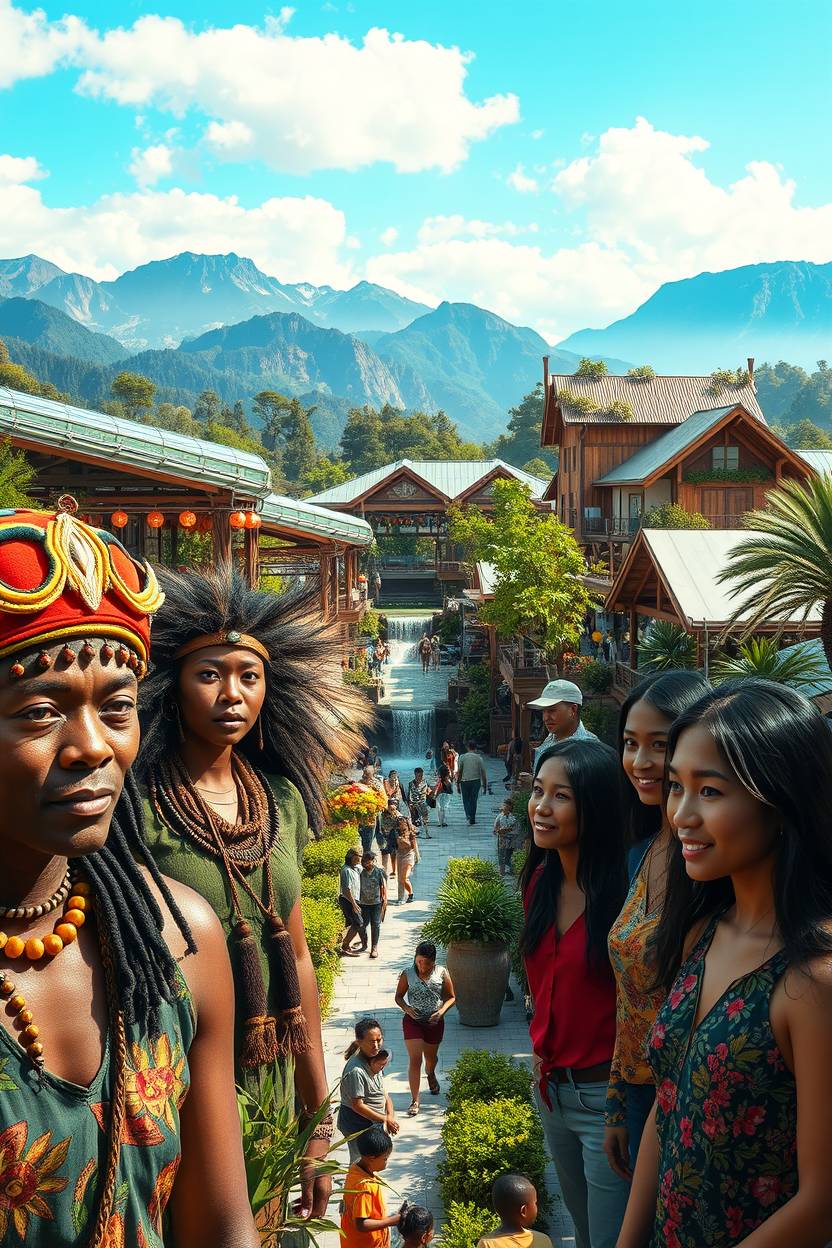
The period between August 18th and 24th is filled with important events for Sustainable Development. On August 19th, World Humanitarian Day celebrates the vital work of humanitarian workers. They risk their lives to help others in need.
Another important day is the International Day for the Remembrance of the Slave Trade and its Abolition on August 23rd. It reminds us of past injustices and the ongoing battle against slavery today.
World Water Week runs from August 23rd to September 1st. It focuses on the need for sustainable water management and access to clean water. This is a key part of achieving sustainable development.

The Importance of August Observances in Advancing Sustainable Development
August is packed with global awareness days and cultural celebrations. These events are key for pushing forward sustainable development. They help bring attention to important issues like environmental protection and social justice.
How Global Awareness Days Drive Policy and Action
Global awareness days are crucial for shaping policies and inspiring action. They focus on big challenges like climate change and human rights. For example, the International Day of Indigenous Peoples raises awareness about indigenous rights and struggles. This encourages governments and organizations to create more inclusive policies.
The Role of Cultural Celebrations in Promoting Sustainability
Cultural celebrations also play a big role in promoting sustainability. Events like Indonesia Constitution Day on August 18th celebrate national heritage. They also highlight the role of good governance in achieving sustainable goals. These celebrations blend cultural values with sustainability goals, leading to a more complete approach to development.
In summary, August’s observances are more than just symbols. They are drivers of change. By using these global awareness days and cultural celebrations, we can make real progress towards a sustainable future.
Aug18th to24th Global Observances and Holidays within Sustainable Development

Between August 18th and 24th, the world comes together for several key events. These events are important for moving forward on sustainable development goals. This time is filled with global observances and holidays that bring attention to important issues and encourage international cooperation.
Week-at-a-Glance: Key Events and Their Significance
The week is filled with important events. World Humanitarian Day on August 19th highlights the need for humanitarian work and the challenges faced by aid workers. Also, International Day for the Remembrance of the Slave Trade and its Abolition on August 23rd reminds us of the slave trade’s history and its lasting effects.
- August 18th: Indonesia Constitution Day – focusing on governance for sustainability.
- August 19th: World Humanitarian Day – focusing on humanitarian challenges and resilience.
- August 23rd: International Day for the Remembrance of the Slave Trade and its Abolition – reflecting on historical injustices and modern slavery.
- August 24th: Ukraine Independence Day – celebrating resilience and sustainability efforts.

Historical Context and Evolution of Late August Observances
These observances have changed over time, showing shifts in global priorities and challenges. For example, World Humanitarian Day now focuses on keeping humanitarian workers safe. The International Day for the Remembrance of the Slave Trade and its Abolition also educates us about the slave trade’s past and its effects today.
The importance of these events is in how they can change public opinion, shape policies, and push for sustainable development. By knowing their history and how they’ve changed, we can see why they’re still important today.
World Humanitarian Day (August19): Supporting Human Dignity
On August 19, the world comes together to honor World Humanitarian Day. This day celebrates the brave and compassionate people who risk everything to help others. It also shines a light on the big challenges they face in dangerous places.
Origins and Purpose
World Humanitarian Day was started by the United Nations in 2008. It remembers the UN bombing in Baghdad on August 19, 2003. This bombing killed 22 people, including Sergio Vieira de Mello, the UN’s Special Representative to Iraq.
The day is to get people all over the world to support humanitarian causes. It’s also to thank humanitarian workers who risk their lives to help others.
2023 Themes and Global Activities
The theme for World Humanitarian Day 2023 is “#ItTakesAVillage.” It shows how important it is for everyone to work together to help those in need. There will be many activities around the world, like campaigns, fundraising, and community programs.
Humanitarian Work’s Connection to Sustainable Development Goals
Humanitarian work is closely tied to the Sustainable Development Goals (SDGs). It helps achieve goals like reducing poverty, improving health and education, and fighting for gender equality. Humanitarian aid lays the groundwork for lasting development, especially in areas hit by conflict or disaster.
| SDG | Humanitarian Contribution |
|---|---|
| SDG 1: No Poverty | Emergency relief and support for economic recovery |
| SDG 3: Good Health and Well-being | Provision of medical aid and health services |
| SDG 4: Quality Education | Support for educational infrastructure and resources |
By supporting humanitarian work, we’re not just saving lives in the moment. We’re also investing in a better future for everyone.
International Day for the Remembrance of the Slave Trade and its Abolition (August23)

This day, on August 23rd, reminds us of the slave trade’s dark history. It also looks at its lasting impact today. It’s a day to remember the past, understand today, and dream of a slavery-free future.
Historical Significance and UNESCO’s Role
UNESCO created this day to honor those who suffered in the slave trade. It’s a time to reflect on slavery’s past and present effects. UNESCO works hard to spread awareness through education and culture.
Modern Slavery Issues and Sustainable Development
Even though the slave trade ended, slavery still exists today. It affects millions of people. This day emphasizes the need to fight modern slavery as part of the Sustainable Development Goals.
| Aspect | Historical Context | Modern Relevance |
|---|---|---|
| Slave Trade | Transatlantic slave trade | Modern slavery and human trafficking |
| UNESCO’s Role | Preservation of historical memory | Educational initiatives and cultural programs |
| Global Commemoration | Remembrance events | Awareness campaigns and advocacy |

Global Commemoration Activities and Educational Initiatives
There are many ways to honor this day. Events include ceremonies, cultural shows, and learning programs. These activities remember the past and talk about slavery today.
Environmental Conservation Observances: Protecting Our Planet
The third week of August is filled with important days for the environment. These days focus on saving our planet, from protecting biodiversity to making food systems sustainable. They remind us all how crucial it is to work together to save our planet.
International Orangutan Day: Biodiversity Protection
August 19 is International Orangutan Day. It shines a light on orangutans and why we must save their homes. Orangutans are not just cute animals; they are key to keeping their ecosystems healthy. Saving their forests also helps with carbon sequestration and supports many species.
World Mosquito Day: Public Health and Climate Change
World Mosquito Day is on August 20. It focuses on how mosquitoes affect our health. Diseases like malaria and dengue fever are big problems, especially in warm places. Climate change is making mosquitoes spread diseases more, which is a big concern for health and the environment.
World Plant Milk Day: Sustainable Food Systems
August 22 is World Plant Milk Day. It celebrates the good things about plant-based milk. Making plant milk uses less water and land than dairy milk. This day encourages us to think about the environmental impact of what we eat and supports eating in a way that’s better for our planet.
These important days in late August show us how connected saving biodiversity, keeping people healthy, and eating sustainably are. By learning more and taking action, we can help make a better future for everyone.
World Water Week (Beginning August24): Addressing Global Water Challenges

The world will gather in Stockholm for World Water Week starting August 24. This event is crucial for tackling global water challenges. Experts, policymakers, and stakeholders will come together to discuss water security and sustainable development.
Key Themes and Focus Areas for2023
The 2023 World Water Week will focus on several key themes. These include water security, sustainable water management, and climate change’s impact on water resources. Sessions, workshops, and presentations will explore these topics, offering insights into current challenges and solutions.
Water Security and Sustainable Development
Water security is closely tied to sustainable development. Access to clean water and sanitation is key for achieving the United Nations’ Sustainable Development Goals (SDGs), especially SDG 6. The week will emphasize the need to integrate water security into development plans.
| Theme | Focus Area | Relevance to SDGs |
|---|---|---|
| Water Security | Access to clean water and sanitation | SDG 6: Clean Water and Sanitation |
| Sustainable Water Management | Efficient use of water resources | SDG 12: Responsible Consumption and Production |
| Climate Change Impact | Mitigating the effects of climate change on water | SDG 13: Climate Action |

Participation Opportunities for Organizations and Individuals
World Water Week offers many ways for organizations and individuals to get involved. You can attend sessions, present research, or join side events. It’s a chance to network, collaborate, and work towards a water-secure future.
Social Justice and Peace Observances
August is a key month for global awareness. It has several observances from the 18th to the 24th. These focus on social justice and peace efforts. They remind us of the ongoing challenges and the work towards a just and peaceful world.
International Day Commemorating Victims of Religious Violence
The International Day Commemorating Victims of Religious Violence is on August 22. It calls for fighting religious intolerance and violence. This day stresses the need for tolerance, understanding, and respect for all religions.
European Day of Remembrance for Victims of Stalinism and Nazism
On August 23, Europe remembers the victims of Stalinism and Nazism. It reflects on the horrors these regimes caused. This day is about keeping history alive to stop future human rights abuses.
Be An Angel Day
Be An Angel Day is also on August 22. It urges people to do kind acts and show compassion. It shows that small actions can help make society more peaceful and just.
These observances are important for raising awareness and inspiring action. Key efforts include:
- Educational programs to promote tolerance and understanding
- Community service projects that foster compassion and empathy
- Advocacy campaigns to address systemic injustices and human rights violations
By joining these observances, we can help a bigger movement towards justice and peace. Reflecting on these days, we see the strength of working together for a fairer world.
National Independence and Cultural Celebrations

Between August 18th and 24th, many countries celebrate their freedom. These events show how freedom and sustainable living are linked. They also celebrate cultural traditions and the strength needed to reach sustainable goals.
Ukraine Independence Day (August24): Resilience and Sustainability
Ukraine celebrates its freedom from the Soviet Union on August 24th. This day is important for Ukrainians and the world. It shows Ukraine’s strength in tough times and its push for a better future.
Afghanistan Independence Day (August19): Development Challenges
Afghanistan marks its freedom from Britain on August 19th. This day reminds us of Afghanistan’s big challenges. The world must help Afghanistan overcome these to achieve a better future.
Indonesia Constitution Day (August18): Governance for Sustainability
Indonesia celebrates its constitution on August 18th. This day shows how good leadership is key to a sustainable future. Indonesia’s story teaches us about the role of effective governance in national progress.
The following table summarizes key aspects of these national independence and cultural celebrations:
| Country | Celebration Date | Significance |
|---|---|---|
| Ukraine | August 24 | Resilience and sustainability in the face of geopolitical challenges |
| Afghanistan | August 19 | Complex development challenges and the need for international support |
| Indonesia | August 18 | Importance of good governance for sustainable development |
In conclusion, these celebrations show different ways countries work towards a sustainable future. By learning about each country’s journey, we can all support their efforts towards a better world.
Media and Communication Observances: Spreading Awareness
Media and communication observances help us understand global challenges. In August, we see many important observances. They show how media, communication, and transportation are key to reaching sustainable development goals.
World Photo Day (August 19): Documenting Environmental Change
World Photo Day is on August 19. It celebrates photography and its role in highlighting important issues. Photos can show how human actions affect the planet, encouraging us to take action.
National Radio Day (August 20): Communication for Development
National Radio Day is on August 20. It emphasizes radio’s role in communication and development. Radio is crucial for reaching people in remote areas, offering information, education, and fun.
National Aviation Day (August 19): Sustainable Transportation
National Aviation Day is also on August 19. It looks at aviation’s role in transportation and its green potential. The industry is exploring eco-friendly options like sustainable fuels and better aircraft designs.
| Observance | Date | Focus Area |
|---|---|---|
| World Photo Day | August 19 | Documenting Environmental Change |
| National Radio Day | August 20 | Communication for Development |
| National Aviation Day | August 19 | Sustainable Transportation |
These observances do more than just raise awareness. They motivate us to work towards a greener future. By using media, communication, and transportation wisely, we can achieve sustainable development goals.
How These Observances Align with UN Sustainable Development Goals

The SDGs help us see why late August’s global events are important. From August 18th to 24th, many observances match up with SDGs. This shows a wide-ranging effort towards sustainable development.
Many of these events support Social Development Goals (SDGs 1-6). For example, World Humanitarian Day on August 19th fits with SDG 1 (No Poverty) and SDG 3 (Good Health and Well-being). It shows how humanitarian work helps reduce poverty and improve health worldwide.
Social Development Goals (SDGs 1-6)
- SDG 1: No Poverty – Supported through humanitarian efforts highlighted on World Humanitarian Day.
- SDG 3: Good Health and Well-being – Advanced through public health observances like World Mosquito Day on August 20th.
- SDG 4: Quality Education – Promoted through educational initiatives on International Day for the Remembrance of the Slave Trade and its Abolition on August 23rd.
Environmental Sustainability Goals (SDGs 7, 11-15)
Days like International Orangutan Day on August 19th and World Plant Milk Day on August 22nd focus on the environment. They stress the need to protect biodiversity and promote sustainable food systems. These efforts align with SDGs 12 (Responsible Consumption and Production) and 15 (Life on Land).
Economic and Institutional Goals (SDGs 8-10, 16-17)
Events like Ukraine Independence Day on August 24th and Afghanistan Independence Day on August 19th highlight SDG 16 (Peace, Justice, and Strong Institutions). They celebrate national sovereignty and strong institutions. World Water Week, starting on August 24th, also focuses on SDG 6 (Clean Water and Sanitation) and SDG 8 (Decent Work and Economic Growth). It emphasizes water security and sustainable management.
Looking at these events through the SDG lens helps us see their combined effect. It shows how they work together to create a more sustainable and fair world.
Practical Ways to Participate in August Sustainable Development Observances

August is filled with sustainable development observances. The world needs our help to make a difference. We can all take part in activities that support these causes.
Educational Activities and Learning Resources
Learning about sustainable development goals is key. Organizations can create workshops, webinars, and online courses. For example, World Humanitarian Day on August 19 can be celebrated with educational programs.
Here are some educational ideas:
- Developing curriculum materials for schools
- Hosting expert-led webinars on sustainable development topics
- Creating online courses on platforms like Coursera or edX
Community Engagement and Local Action
Getting involved in your community is important. You can help with events, clean-up campaigns, and awareness drives. For instance, World Water Week starting on August 24 can be marked with water conservation efforts.
| Observance | Community Engagement Idea |
|---|---|
| World Humanitarian Day (Aug 19) | Organize a charity run or fundraising event |
| International Day for the Remembrance of the Slave Trade and its Abolition (Aug 23) | Host a historical exhibition or cultural event |
| World Water Week (Starting Aug 24) | Conduct water conservation workshops |
Digital Campaigns and Global Advocacy
Digital campaigns can spread the word about sustainable development. Social media is a great tool for this. For example, a campaign for World Photo Day on August 19 can ask people to share environmental photos.
By using these strategies, we can all help make a difference in August. Together, we can work towards a more sustainable future.

Conclusion: Leveraging Global Observances for a More Sustainable Future
As we face the challenges of global sustainability, using global observances is key. From August 18th to 24th, important events showed us the need for working together. They highlighted the importance of a sustainable future.
These events, like World Humanitarian Day and International Day for the Remembrance of the Slave Trade, show how social justice, environmental care, and economic growth are linked. By joining in, we can help make the world more just and green.
To build a sustainable future, we must keep spreading awareness and pushing for policy changes. This way, we can grow a culture of sustainability in every part of society. It’s about changing our communities and the world’s governance.
Let’s use global observances to make real changes and impact sustainable development. Together, we can make a better, more resilient future for everyone.

Key Takeaways
- World Humanitarian Day on August 19th honors humanitarian workers.
- The International Day for the Remembrance of the Slave Trade and its Abolition is observed on August 23rd.
- World Water Week starts on August 23rd, focusing on sustainable water management.
- These events are crucial for raising awareness about sustainable development issues.
- They promote global cooperation and action towards achieving sustainable development goals.








